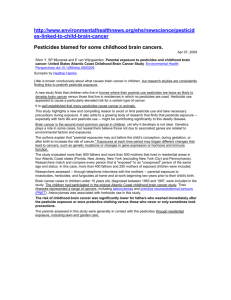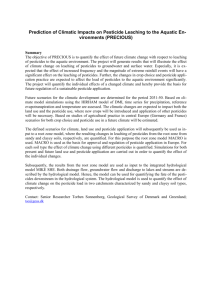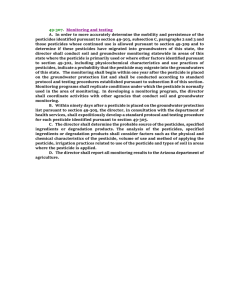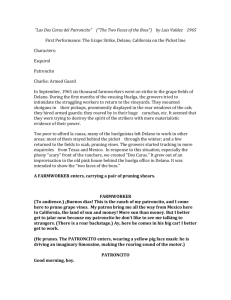Border Reg Workplan MIA 02-27-12
advertisement
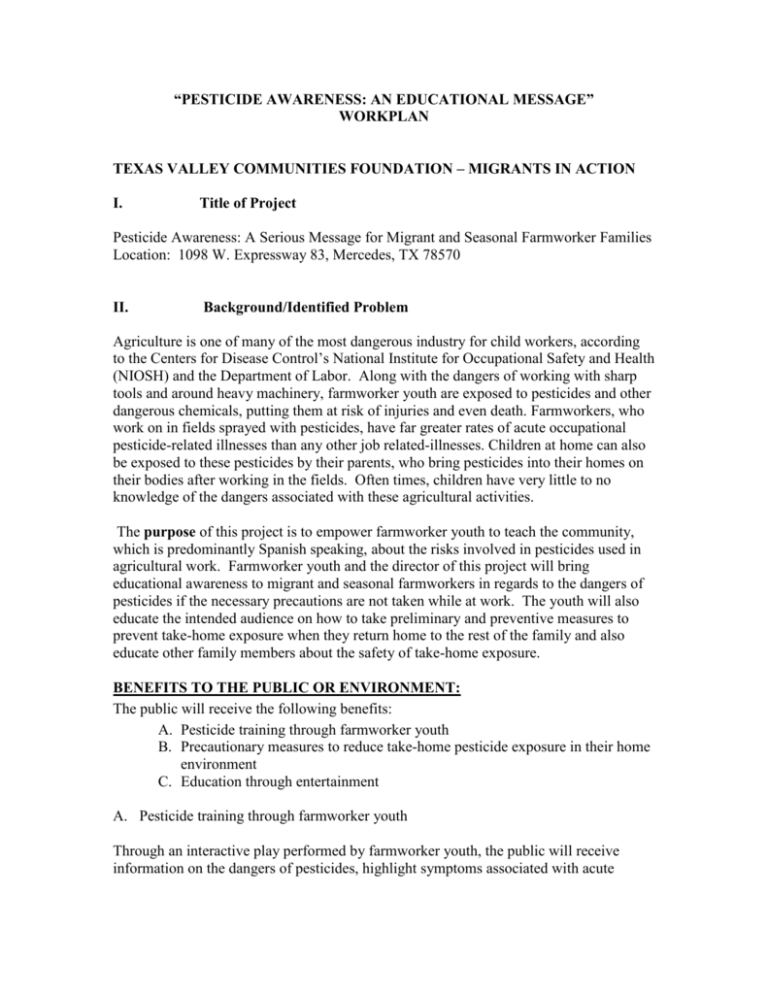
“PESTICIDE AWARENESS: AN EDUCATIONAL MESSAGE” WORKPLAN TEXAS VALLEY COMMUNITIES FOUNDATION – MIGRANTS IN ACTION I. Title of Project Pesticide Awareness: A Serious Message for Migrant and Seasonal Farmworker Families Location: 1098 W. Expressway 83, Mercedes, TX 78570 II. Background/Identified Problem Agriculture is one of many of the most dangerous industry for child workers, according to the Centers for Disease Control’s National Institute for Occupational Safety and Health (NIOSH) and the Department of Labor. Along with the dangers of working with sharp tools and around heavy machinery, farmworker youth are exposed to pesticides and other dangerous chemicals, putting them at risk of injuries and even death. Farmworkers, who work on in fields sprayed with pesticides, have far greater rates of acute occupational pesticide-related illnesses than any other job related-illnesses. Children at home can also be exposed to these pesticides by their parents, who bring pesticides into their homes on their bodies after working in the fields. Often times, children have very little to no knowledge of the dangers associated with these agricultural activities. The purpose of this project is to empower farmworker youth to teach the community, which is predominantly Spanish speaking, about the risks involved in pesticides used in agricultural work. Farmworker youth and the director of this project will bring educational awareness to migrant and seasonal farmworkers in regards to the dangers of pesticides if the necessary precautions are not taken while at work. The youth will also educate the intended audience on how to take preliminary and preventive measures to prevent take-home exposure when they return home to the rest of the family and also educate other family members about the safety of take-home exposure. BENEFITS TO THE PUBLIC OR ENVIRONMENT: The public will receive the following benefits: A. Pesticide training through farmworker youth B. Precautionary measures to reduce take-home pesticide exposure in their home environment C. Education through entertainment A. Pesticide training through farmworker youth Through an interactive play performed by farmworker youth, the public will receive information on the dangers of pesticides, highlight symptoms associated with acute pesticide poisoning, the importance of seeking medical attention, and raising awareness about chronic effects of pesticide exposure. Migrants in Action (MIA) will work with local farmworker youth to create a publication highlighting the plight of farmworker families, especially children, and include important information on the dangers of pesticides for children under the guidance of the Association of Farmworker Opportunity Programs’ (AFOP) Health & Safety Programs. AFOP’s Health & Safety Team have created materials through the EPA for Project HOPE and Project LEAF, which educate farmworkers on the dangers of pesticides and how to prevent exposure, both in the workplace and at home. B. Precautionary measures to reduce take-home pesticide exposure in their home environment Pesticide residues from the plants and soil where farmworkers spend much of their day pose serious health risks for them. Often invisible to the naked eye, the residues cling to skin, clothing, hats, boots, tools, lunch coolers, car seats, and any other items in the work environment. Farmworkers often do not even realize they are bringing these residues into their homes, where their children are then exposed to toxic substances that can make them sick. Sometimes workers will bring pesticides used at work to their home to take care of a pest problem. These products are not for residential use and are very dangerous to families when used in the home. All of the situations mentioned above are known as take-home pesticide exposure. Through the interactive play and publication created by the youth, the public will receive information on the dangers of pesticide exposure and precautionary measures to minimize pesticide exposure in their homes. C. Education through entertainment The information will be delivered using the script of “El Moscas y Los Pesticidas.”, a script that was developed by the EPA in Region 6. The play is in Spanish, which will accommodate the language of the predominately Spanish speaking community in South Texas. The migrant youth council performing the play is also interested in translating the play in English in order to perform it to English speaking students. The play has a serious and educational message that is delivered in an interactive and comical fashion through life-size insect characters. The program is designed to provide information on pesticide safety and how to prevent take-home exposure. By providing the information in an entertaining format, the public will be more receptive to the message and will increase the audience participation. The key players and/or stakeholders for this project are the farmworker service providers’ in the area. Some of these agencies include: local Migrant Education Programs; Motivation, Education and Training (MET); Teaching and Mentoring Communities, (TMC); Texas A&M Agricultural Extension Center, and the University of Texas-Pan American (UTPA). These agencies will provide the project a target audience for information dissemination or for the performance of the play. MIA has had past experience with this project. The “Children in the Fields” Campaign Youth Council, a student organization at UTPA composed of farmworker youth, participated in the performance of this play at a local faith-based event titled “El Dia De Los Migrantes” (“Day of the Migrants” in Spanish). III. Objectives The intent of this project is to satisfy the Border 2012 objective of Pesticide Safety Awareness. The primary objectives of this project are: To educate migrant and seasonal farmworker families, including farmworker youth, educators and the general public in the Texas/Mexico border through literature and presentations on the dangers of pesticides; To educate migrant and seasonal farmworker families, including farmworker youth, educators and the general public in the Texas/Mexico border through literature and presentations on the precautionary measures to ensure that pesticides are not carried into the home environment; To educate migrant and seasonal farmworker families, including farmworker youth, educators in the Texas/Mexico border through the performance of the play “El Moscas y Los Pesticidas” by farmworker youth on pesticide precautionary measures. The plan for achieving the objective is by providing informational sessions and play presentations to the targeted audience specified. MIA will collaborate with AFOP’s Health & Safety Programs to distribute to the farmworker families information on the dangers of pesticides and precautionary measures. The primary audience will be migrant and seasonal farmworker youth and their families. An estimated number of approximately 1,000 people will benefit from this project. Farmworker families are deemed the most vulnerable for pesticide exposure. IV. Tasks/Activities of Work Plan Farmworker youth will perform the play and MIA’s Executive Director will organize workshop presentations to farmworker service provider organizations in the Texas/Mexico border. MIA will collaborate with migrant service providers to present to their clients, which include farmworker families. The presentations will be via informational workshops with hand-out materials and the production of the play. (The timeline is in Section VI) MIA will also work closely with AFOP’s Health & Safety Programs to use and replicate their materials on Pesticide Safety and the prevention of take-home pesticide exposure. All educational materials used will be produced by AFOP in accordance with EPA’s regulations. V. Measurable Results OUTPUTS AND OUTCOMES: P r oj e ct ’s T a s k s Activities: 1. Recruit migrant and seasonal farmworker youth to assist in the implementation of the project 2. Interview youth for commitment and dedication 3. Conduct auditions for character placement 4. Review script and rehearse script “El Moscas y Los Pesticidas” 5. Create a pesticide awareness publication 6. Provide training for youth on role-playing and/or acting 7. Contact migrant and seasonal farmworker providers for performance scheduling 8. Present/perform once in the Association of Migrant Educators of Texas Conference in South Padre Island (if proposal is accepted by committee) 9. Evaluate performances 10. Present/perform approximately for 10 different audiences within the boundaries of South Texas – Brownsville to Laredo 11. Assess and evaluate audience knowledge of pesticides before and after performances based on a pre and post test 12. Reports will be submitted upon requirement of grant 13. Approximately 1000 people in the community will receive this message 14. Products such as brochures or materials will be produced upon need during presentations and/or performances Outputs: 1. Approximately 500 parents/families will receive this training 2. Approximately 400 students will receive this training Outcomes: 1. Afford an opportunity for migrant and seasonal farmworker youth, an underserved and underrepresented population, to partake in a theatrical performance activity 2. Educate the public, especially the farmworker community, on pesticide safety 3. Increase public awareness on the dangers of pesticides 4. Reduce the risk of pesticide exposure of farmworkers while working in the fields 5. Reduce the risk of pesticide exposure brought into the home by farmworkers 6. Entertain the audience through a comedy relief but deliver a serious message 7. Parents will be asked through the raising of their hands if they commit to relay message to the rest of the family. VI. Gantt Schedule PROJECT TIMELINE (18 months): Timeline indicates upon funds received VII. Quality Assurance/Quality Control (QA/QC) as applicable - NA VIII. Staff and Sub-consultant Capabilities QUALIFICATIONS AND EXPERTISE: 1. Ms. Noemi Ochoa, MIA’s Executive Director 35 years experience in Migrant Education, AFOP’s Children in the Fields Campaign Texas Regional Coordinator Farmworker Youth Leadership Development experience 2. Ms. Veronica Burgoa, United ISD Migrant Education Program Coordinator 16 years experience in Migrant Education Farmworker Youth Leadership Development experience AFOP’s Children in the Fields Campaign Advocate 3. MIA’s “Children in the Fields” Youth Council at UTPA. The youth council members are farmworker college students that will assist in the production of the materials and the play under the supervision of MIA’s Executive Director. 4. United Independent School District migrant farmworker students in Laredo, Texas, will produce educational materials and participate in the production of the play. IX. Cost Breakdown Budget Budget Breakdown and estimated cost shall coincide with project activities. The budget table may include the following categories. Staff/Personnel Fees: Labor –Proposed Team Work Composition Should be segregate by the type of professional experience and anticipated man-hours required and cost. Other Direct Costs Sub-consultant Indirect Costs Travel Supplies Misc. Costs: Telephone, Reproduction, other, etc. In the same table provide the match contribution/leverage to be provided by the project sponsor or other project participants. Refer to attached sample budget table. X. Reporting Schedule to BECC/EPA The BECC expects the following: Progress reports will be submitted quarterly or in shorter periods, depending upon the total duration of the project. Quarterly reports in electronic format will be submitted to the BECC and EPA. Final report to be presented 60 days after project completion to the BECC in electronic file with backup required backup documents included. See the following for report submittal timelines: Quarterly reports are due 25 days after the end of each quarter Final report is due 60 days after project completion or termination. Reports must contain information on: a comparison of actual accomplishments to the objectives established for the period. outputs (& outcomes) quantified where possible the reasons for slippage if established objectives were not met additional pertinent information including, when appropriate, analysis and explanation of cost overruns or high unit costs Note 1: - The term “output” means an environmental activity, effort, and/or associated work products related to an environmental goal or objective, that will be produced or provided over a period of time or by a specified date. Outputs may be quantitative or qualitative but must be measurable during an assistance agreement funding period. Note 2: - The term “outcome” means the result, effect or consequence that will occur from carrying out an environmental program or activity that is related to an environmental or programmatic goal or objective. Outcomes may be environmental, behavioral, health-related or programmatic in nature, must be quantitative, and may not necessarily be achievable within an assistance agreement funding period.







